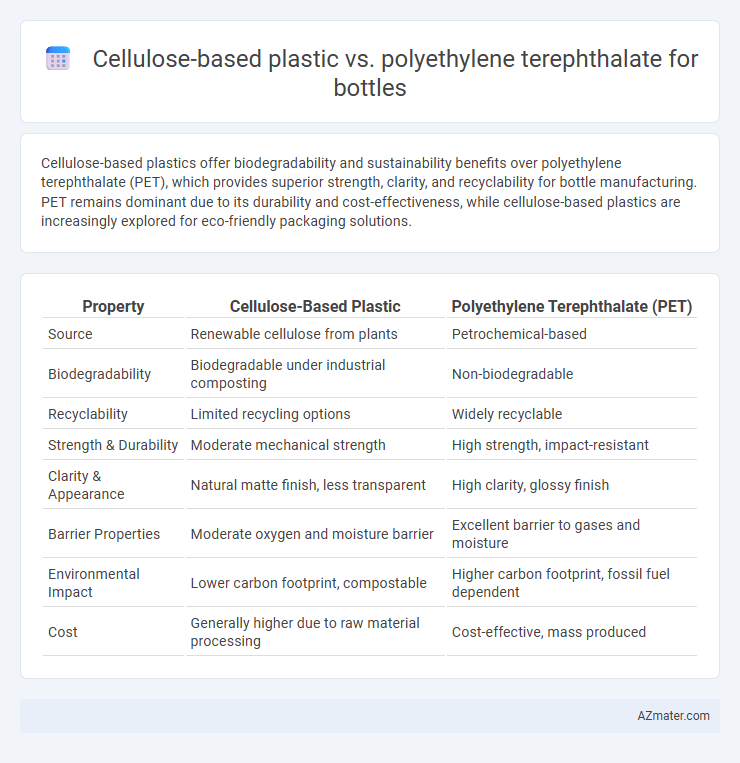Cellulose-based plastics offer biodegradability and sustainability benefits over polyethylene terephthalate (PET), which provides superior strength, clarity, and recyclability for bottle manufacturing. PET remains dominant due to its durability and cost-effectiveness, while cellulose-based plastics are increasingly explored for eco-friendly packaging solutions.
Table of Comparison
| Property | Cellulose-Based Plastic | Polyethylene Terephthalate (PET) |
|---|---|---|
| Source | Renewable cellulose from plants | Petrochemical-based |
| Biodegradability | Biodegradable under industrial composting | Non-biodegradable |
| Recyclability | Limited recycling options | Widely recyclable |
| Strength & Durability | Moderate mechanical strength | High strength, impact-resistant |
| Clarity & Appearance | Natural matte finish, less transparent | High clarity, glossy finish |
| Barrier Properties | Moderate oxygen and moisture barrier | Excellent barrier to gases and moisture |
| Environmental Impact | Lower carbon footprint, compostable | Higher carbon footprint, fossil fuel dependent |
| Cost | Generally higher due to raw material processing | Cost-effective, mass produced |
Introduction: The Quest for Sustainable Bottle Materials
Cellulose-based plastic offers a renewable and biodegradable alternative to conventional polyethylene terephthalate (PET) used in bottle manufacturing. Derived from plant fibers, cellulose-based plastics reduce reliance on fossil fuels and decrease environmental pollution through enhanced compostability. PET remains widely used due to its strength and recyclability, but concerns over microplastic waste and fossil resource depletion drive innovation toward cellulose-derived solutions.
Overview: Properties of Cellulose-Based Plastics
Cellulose-based plastics exhibit high biodegradability, excellent oxygen barrier properties, and moderate tensile strength, making them suitable for sustainable packaging solutions. Their renewable cellulose content enhances environmental compatibility compared to petroleum-based plastics like polyethylene terephthalate (PET). Despite lower heat resistance and moisture sensitivity, cellulose-based plastics offer superior compostability and reduced carbon footprint in bottle applications.
Polyethylene Terephthalate (PET): Features and Applications
Polyethylene terephthalate (PET) is a lightweight, strong, and highly recyclable thermoplastic widely used in bottle manufacturing due to its excellent clarity, chemical resistance, and barrier properties against moisture and gases. PET's high tensile strength and durability enable efficient transportation and storage, making it the preferred choice for beverages, personal care products, and food packaging. Its widespread recyclability supports sustainability initiatives, reducing environmental impact compared to petroleum-based plastics like cellulose-based alternatives.
Environmental Impact: Cellulose-Based Plastics vs PET
Cellulose-based plastics offer a significantly lower environmental impact compared to polyethylene terephthalate (PET) by being biodegradable and sourced from renewable biomass, reducing plastic pollution and fossil fuel dependency. PET production involves intensive energy use and releases greenhouse gases, contributing to global warming and long-term environmental harm, while cellulose plastics decompose naturally, minimizing landfill accumulation. Life cycle assessments highlight cellulose-based bottles as a sustainable alternative with reduced carbon footprint and enhanced compostability compared to conventional PET bottles.
Biodegradability and Compostability Comparison
Cellulose-based plastics exhibit superior biodegradability and compostability compared to polyethylene terephthalate (PET), as cellulose-derived materials naturally break down through microbial activity in soil and compost environments within weeks to months. PET, a petroleum-based polymer, requires industrial recycling processes and can persist for hundreds of years in landfills due to its resistance to microbial degradation and chemical stability. Biodegradability metrics indicate cellulose-based bottles align better with circular economy goals by minimizing plastic pollution and promoting organic matter recovery.
Manufacturing Processes and Scalability
Cellulose-based plastic bottles are produced through the regeneration of cellulose fibers derived from renewable sources like wood pulp, involving processes such as solvent extrusion and biopolymer casting, which generally require more specialized equipment and longer production times compared to conventional methods. Polyethylene terephthalate (PET) bottles utilize well-established injection molding and blow molding techniques that enable rapid manufacturing at high volumes, benefiting from mature supply chains and extensive industrial scalability. While cellulose-based plastics offer sustainability advantages, PET remains the dominant material in bottle production due to its cost-effective manufacturing infrastructure and scalability for mass-market demands.
Performance: Mechanical Strength and Barrier Properties
Cellulose-based plastics exhibit high mechanical strength with superior tensile properties, making them resistant to deformation and impact, while polyethylene terephthalate (PET) offers exceptional durability and flexibility suited for reusable bottles. In terms of barrier properties, PET provides excellent resistance to moisture, oxygen, and carbon dioxide permeation, ensuring longer shelf life for beverages, whereas cellulose-based plastics generally have moderate barrier capabilities that may require coatings or treatments to match PET performance. The combination of mechanical robustness and superior barrier efficacy positions PET as the preferred material for high-performance bottle applications, particularly in food and beverage packaging.
Cost Analysis: Production and End-of-Life
Cellulose-based plastic for bottles generally incurs higher production costs due to expensive raw materials and more complex manufacturing processes compared to polyethylene terephthalate (PET), which benefits from well-established, large-scale production and lower material expenses. End-of-life costs for cellulose-based plastics are often lower because they are biodegradable and compostable, reducing long-term waste management expenses, while PET requires energy-intensive recycling processes or landfill disposal. The economic feasibility of cellulose-based bottles hinges on balancing these higher upfront production costs against potential savings in waste treatment and environmental compliance.
Consumer Safety and Regulatory Considerations
Cellulose-based plastics for bottles offer enhanced biodegradability and lower chemical leaching risks compared to polyethylene terephthalate (PET), aligning with stricter consumer safety standards. Regulatory bodies such as the FDA and EFSA increasingly favor cellulose-derived materials due to their renewable origin and reduced toxicological concerns in food and beverage packaging. PET remains broadly approved but faces scrutiny over microplastic release and recycling challenges that influence evolving safety regulations.
Future Prospects: Market Trends and Innovations
Cellulose-based plastics are gaining traction in the bottle market due to their biodegradability and renewable sourcing, aligning with increasing consumer demand for sustainable packaging solutions. Innovations in enhancing mechanical strength and barrier properties are expanding their applicability, targeting a projected market growth rate of over 15% annually by 2030. Polyethylene terephthalate (PET) maintains dominance due to its recyclability and cost-effectiveness, but shifts towards bio-based PET and enhanced recycling technologies suggest a hybrid approach may define future industry standards.

Infographic: Cellulose-based plastic vs Polyethylene terephthalate for Bottle
 azmater.com
azmater.com